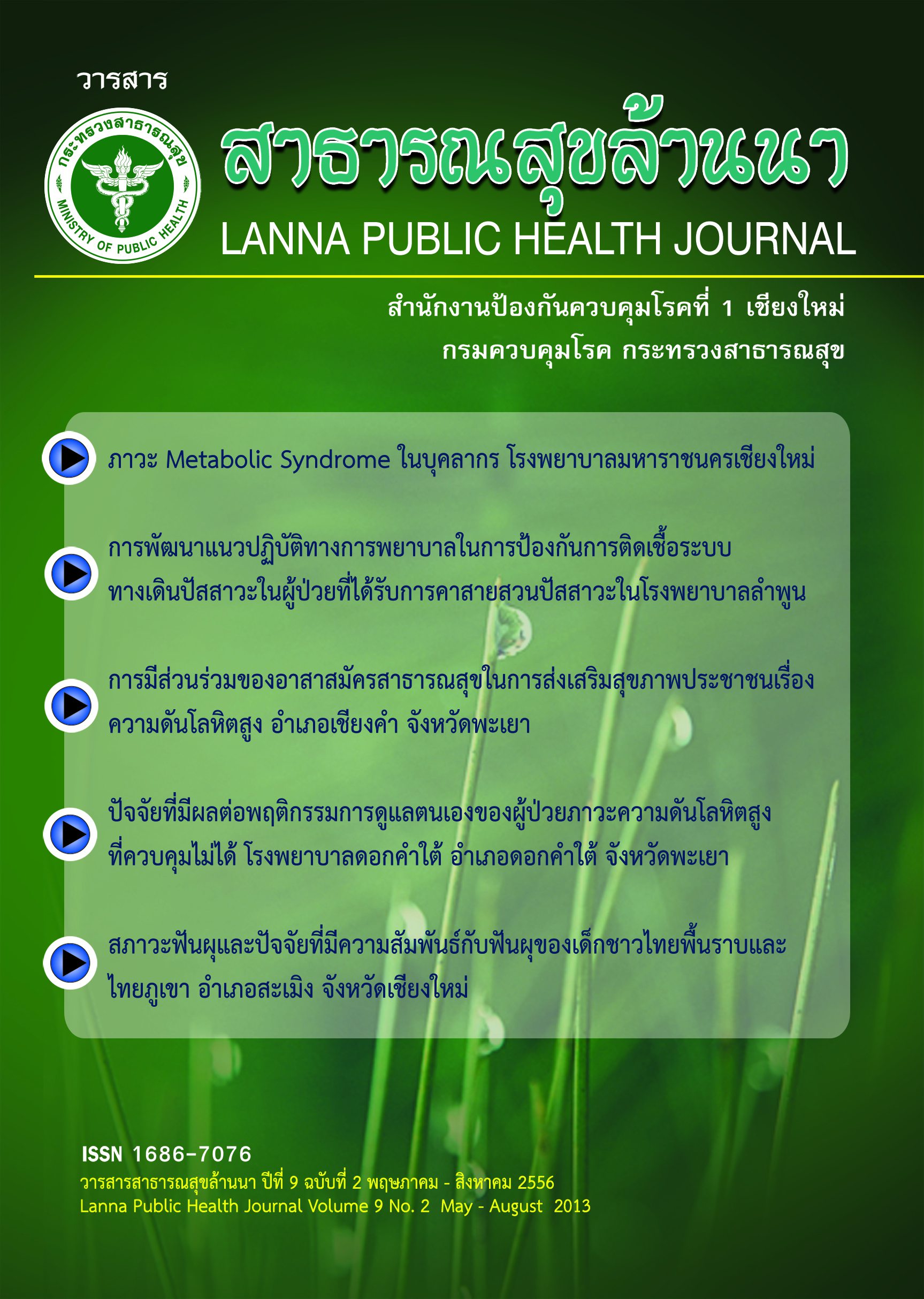ภาวะ Metabolic Syndrome ในบุคลากร โรงพยาบาลมหาราชนครเชียงใหม่
คำสำคัญ:
Metabolic Syndrome, บุคลากรทางการแพทย์, การตรวจสุขภาพ, โรงพยาบาลบทคัดย่อ
ภาวะ Metabolic Syndrome (MS) เป็นปัจจัยเสี่ยงสำคัญต่อการเกิดโรคหัวใจและหลอดเลือด ซึ่งกลุ่มโรคเหล่านี้ เป็นสาเหตุการตายอันดับหนึ่งของประชากรในปัจจุบัน ความชุกของภาวะ MS นี้แตกต่างกันไปตามเชื้อชาติ ถิ่นที่อยู่ และอาชีพ การศึกษาครั้งนี้มีวัตถุประสงค์เพื่อค้นหาความชุกและปัจจัยที่เกี่ยวข้องกับภาวะ MS ในบุคลากรของโรงพยาบาลมหาราชนครเชียงใหม่ โดยทำการศึกษาเชิงวิเคราะห์ภาคตัดขวาง เก็บข้อมูลจากแบบสอบถาม การตรวจร่างกาย การตรวจเลือดทางห้องปฏิบัติการ ในการตรวจสุขภาพประจำปีของบุคลากร ระหว่างเดือนมีนาคม - มิถุนายน 2556 ผลการศึกษาพบว่า มีบุคลากรโรงพยาบาลเข้าร่วมการศึกษาครั้งนี้จำนวน 3,209 คน พบความชุกของภาวะ MS ร้อยละ 16.1 พบความชุกในเพศชาย (ร้อยละ 26.5)มากกว่าเพศหญิง (ร้อยละ 13.7) (P < 0.001) ปัจจัยที่ส่งผลต่อการเพิ่มขึ้นของภาวะ MS ได้แก่ อายุที่เพิ่มขึ้น ดัชนีมวลกายที่เพิ่มขึ้น การมีโรคความดันโลหิตสูง โรคเบาหวานและโรคไขมันในโลหิตสูง โดยบุคลากรอายุน้อยกว่า 35 ปี พบความชุกของภาวะ MS ร้อยละ 9.2 แต่หากอายุมากกว่า 50 ปี ความชุกจะสูงขึ้นเป็นร้อยละ 26.0 (P < 0.001) ในขณะที่ผู้มีดัชนีมวลกายมากกว่า 30 กก./ตร.ม. พบความชุกของภาวะ MS ถึงร้อยละ 60.6 นอกจากนั้นอาชีพคนงานและเจ้าหน้าที่ให้การช่วยเหลือผู้ป่วยมีความชุกของภาวะ MS สูงที่สุด คือ ร้อยละ 23.2 (OR 2.6, 95% CI 2.0-3.3 เมื่อเทียบกับอาชีพพยาบาล) จากการศึกษาครั้งนี้สรุปได้ว่า ความชุกของภาวะ MS ในบุคลากรโรงพยาบาล พบได้สูงในทุกกลุ่มอาชีพ โดยเฉพาะอย่างยิ่งกลุ่มคนงาน เจ้าหน้าที่ให้การช่วยเหลือผู้ป่วยและผู้ช่วยพยาบาล ควรมีมาตรการในการให้การดูแลรักษาและป้องกันภาวะ MS ในบุคลากร เพื่อป้องกันการเจ็บป่วยจากโรคหัวใจและหลอดเลือดในอนาคต
เอกสารอ้างอิง
ชวินทร์ เลิศศรีมงคล, ชัยสิริ อังกุระวรานนท์, พนิดา ธงทอง, พิมพ์พร พรหมคาตัน, วินธนา คูศิริสิน. ความชุกของ Metabolic Syndrome ในแผนกผู้ป่วยนอกภาควิชาเวชศาสตร์ครอบครัว. วารสารสาธารณสุขล้านนา 2551; 4(3): 390-9.
ศิวากร พรตระกูลพิพัฒน์, แก้วใจ เทพสุธรรมรัตน์, ทติยา เทพขุนทอง, ธงชัย ประฎิภาณวัตร. ดัชนีความเสี่ยงต่อเบาหวานของไทยรูปแบบประยุกต์กับการคัดกรองกลุ่มอาการทางเมแทบอลิก. ศรีนครินทร์เวชสาร 2554; 26(3): 213-24.
อุทัย เพ็งธรรม. ความชุกของกลุ่มอาการเมตาบอลิกในบุคลากรโรงพยาบาลลำปาง. ลำปางเวชสาร 2554; 32(1): 11-7.
Alberti K. G., Eckel R. H., Grundy S. M., et al.. Harmonizing the metabolic syndrome: a joint interim statement of the International Diabetes Federation Task Force on
Epidemiology and Prevention; National Heart, Lung, and Blood Institute; American Heart Association; World Heart Federation; International Atherosclerosis Society; and
International Association for the Study of Obesity. Circulation 2009; 120(16): 1640-45.
Alberti K. G., Zimmet P., Shaw J. & IDF Epidemiology Task Force Consensus Group. The metabolic syndrome-a new worldwide definition. Lancet 2005; 366: 1059-62.
Boonyavarakul A., Choosaeng C., Supasyndh O. & Panichkul S. Prevalence of the metabolic syndrome, and its association factors between percentage body fat and body mass index in rural Thai population aged 35 years and older. J Med Assoc Thai 2005; 88 Suppl 3: S121-30.
Grundy S. M. Metabolic syndrome pandemic. Arterioscler Thromb Vasc Biol 2008; 28:629-636.
Grundy S. M., Brewer H. B.Jr., Cleeman J. I., et al. Definition of metabolic syndrome: report of the National Heart, Lung, and Blood Institute/American Heart Association conference on scientific issues related to definition. Arterioscler Thromb Vasc Biol 2008; 24:e13-8.
Hsing A. W., Sakoda L. C. & Chua S.Jr. Obesity, metabolic syndrome, and prostate cancer.Am J Clin Nutr 2007; 86: s843-s857.
International Diabetes Federation. The IDF consensus worldwide definition of the metabolic syndrome. Belgium: International Diabetes Federation; 2006.
Kotronen A. & Yki-Jarvinen H. Fatty liver: a novel component of the metabolic syndrome. Arterioscler Thromb Vasc Biol 2008; 28(1): 27-38.
Lohsoonthorn V., Lertmaharit S. & Williams M.A. Prevalence of metabolic syndrome among professional and office workers in Bangkok, Thailand. J Med Assoc Thai 2007; 90(9): 1908-15.
National Cholesterol Education Program Expert Panel on Detection, Evaluation, Treatment of High Blood Cholesterol in Adults. Third Report of the National Cholesterol
Education Program (NCEP) Expert Panel on Detection, Evaluation, and Treatment of High Blood Cholesterol in Adults (Adult Treatment Panel III) final report.
Circulation 2002; 106(25): 3143-421.
Palacios-Rodriguez RG., Paulin-Villalpando P., Lopez-Carmona JM., Valerio-Acosta Mdel M. & Cabrera-Gaytan DA. [Metabolic syndrome in health care personnel from a primary care unit]. Rev Med Inst Mex Seguro Soc 2010; 48(3): 297-302.
Santibhavank P. Prevalence of metabolic syndrome in Nakhon Sawan population. J Med Assoc Thai 2007; 90(6):1109-15.
Taylor V. H. & Macqueen G. M.. Cognitive dysfunction associated with metabolic syndrome. Obes Rev 2007; 8(5): 409-18.
World Health Organization. Global status report on noncommunicable disaeses 2010. Geneva: World Health Organization; 2011. P.9-10.
World Health Organization. Cardiovascular diseases (CVDs) [Online]. Available from URL:http://www.who.int/mediacentre/ factsheets/fs317/en/ Accessed on July 1, 2013.








